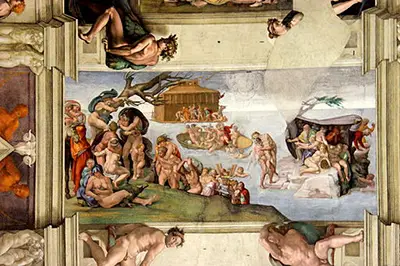He was a Renaissance sculptor, painter, architect, and poet. A number of his paintings, sculptures and architecture rank amongst some of his most famous works. This includes the frescoes he painted between 1508 and 1512 on the ceiling of the Vatican’s Sistine Chapel. One of those frescoes is The Flood.
Inside the Sistine Chapel, looking to the top of it viewers can see a series of paintings (Frescoes) that depict nine scenes from the Book of Genesis. It was Pope Julius II in 1508 who commissioned the paintings.
Michelangelo started the work in 1508 and took four years to complete all nine paintings. One of the paintings depicts ‘The Flood’. Its size is approximately 10 feet by 18 feet in size. For the viewer looking at the picture, on the left of the scene there can be seen a group of desperate people seeking protection on a mountain top. It shows them looking for safety from the increasing water levels.
On the right, there is another who are seeking shelter from the rain. Also, in the middle of the picture, there is a small boat that looks as if it is about to capsize while in the background is Noah’s Ark. It is the only ship that would survive the flood.
In painting The Flood and other scenes from the Book of Genesis, Michelangelo did most of the work himself over a period of four years. Instead of coming up with new or making use of complex painting techniques, Michelangelo is said to have opted to paint using traditional techniques.
When viewing the people in the picture what comes through with the well-defined bodies is his love of sculptures. In his painting of The Flood, Michelangelo makes good use of the human form. Although painting was not his preferred medium according to some, his paintings appear like sculptures. The figures in each scene symbolise both strength and beauty. The work that Michelangelo did on the painting is said to have made a great impression on his equals as well as future artists.
The paintings by Michelangelo in the Sistine Chapel all have a strong religious theme. In the central section of the ceiling, Michelangelo painted nine panels with each one showing a scene from the Book of Genesis.
The nine panels are organised into three groups with three scenes in each. Each of the three pictures in the group forms a part of the Bible story. Of the three groups, the third group depicts Humanity’s troubles and more particularly the family of Noah. All nine panels are believed to represent a visual symbol of people's need for a covenant with God.
Focusing on the meaning of ‘The Flood’ there is a view that it is looking to provoke the observer into thinking about the desperation of those in danger from the flood.
It looks to make the viewer question God’s justice in wiping out humanity to erase the sins of the wicked but saving Noah and his family. Because the figures in the painting are small and tightly grouped, some believe that it undermines its emotional impact and makes the story tougher to follow.


